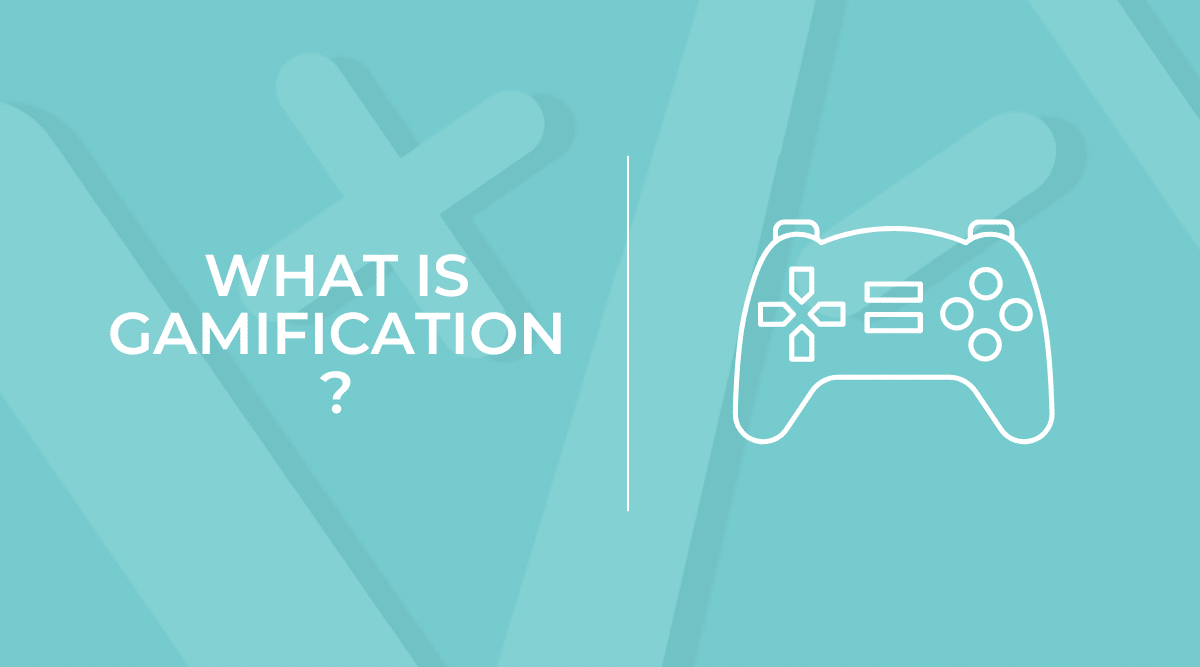Over the course of the past 10 years, gamification has become a hot button topic. Businesses and individuals alike toss around the topic regularly – and while it sounds cool, what exactly does it mean?
Gamification covers a wide range of theories and applications which makes it difficult to define.
What is gamification?
To put it in simply, gamification is the process of applying game-mechanics and theories to non-game contexts.
Seems like a simple answer, right? So why does everyone seem so confused about it? That answer is complicated, because the truth is gamification is a massive term that covers a very wide range of contexts.
In some cases, gamification is simply applying a points system to a specific task or displaying a productivity leaderboard where everyone can see it at work. On the opposite end of the spectrum, immersive roleplay experiences with the goal of education are also considered gamification. This is where things begin getting a little murky, and questions about gamification typically arise.
The History of Gamification
In order to completely understand gamification, it is important to know where it came from. However, much like its definition, the history of gamification is a bit confusing.
The term gamification first appeared around 2002 when British computer programmer Nick Pelling began using the term. Prior to 2002, no one used or even heard the term, but that doesn’t mean that gamification wasn’t happening.
Gamification to solve starvation:
In fact, there is evidence of gamification dating back to the ancient kingdom of Lydia according to Greek historian Herodotus. During a major famine which lasted nearly 20 years, the King established a policy in which the kingdom would eat one day and play games on the next to save their food supply and distract the people from their hunger. Seems a little too good to be true, but this technique allowed the kingdom to thrive rather than starve.
Gamification to create loyalty:
Fast forward quite a few years, and we see the persuasive power of gamification appear in the late 1890’s. S&H Green Stamps began selling special stamps to reward their loyal customer – sound familiar? This same gamification technique is used today by major retailers such as Chipotle, Amazon, and many more!
Gamification in education:
In the early 1900’s, the Boy Scouts of America were founded and began rewarding young men and boys with badges in exchange for their mastery of a skill or activity, supporting the principles of the organization, or for attending a special event. This instance of rewarding in exchange for a desired behavior is perhaps the first instance of using gaming elements in education – but it certainly was not the last.
Gamification for employees:
In 1973, Charles A Coonradt released ‘The Game of Work’, a book to address the issue of rapidly decreasing productivity at the time. Coonradt noted the simultaneous rise in popularity of sports and recreational equipment and introduced the potential solution of fun-and-games at work for the first time. While this book has remained popular for those looking to solve productivity woes, the idea didn’t immediately take off at its date of publish, we don’t see gamification enter the workforce until much later.
Gamification takes off:
We don’t see Coondradt’s work spiking interest in gamification at work immediately, but we do see evidence that the world is catching on to the potential power of games. In 1978, MUD1, the first ever multi-user dungeon video game is released. By today’s standards, the game isn’t exactly knocking anyone’s socks off; but at the time, it was the first experience which combined a video game and socialization. This acted as a major catalyst for future iterations of social gaming with the likes of Foursquare and Fortnite following its footsteps many years later.
MUD1 wasn’t the only company beginning to harness the power of games, in the early 80’s, American Airlines took a page from S&H Green Stamp’s book and released the world’s first ever frequent flyer program. This now very common use case of gamification was revolutionary for the time, creating an explosion of loyalty and frequent patronage rewards programs.
In addition to catching the attention of marketing departments and gaming companies, the potential of leveraging computer games knack for engaging users became a hot topic amongst academics. Multiple articles were released in the early 80’s which explored the possibility of applying what worked in computer games to other areas of life – such as education. These studies are the first mention of definition of gamification that we recognize today – applying game mechanics to non-game environments and tasks.
From this point forward, we begin to see a shift in how seriously the world takes the power of games. Game designers begin releasing studies and player personas to identify different ways users approach games – which are still used in game design today.
Finally, in 1999 Stephen W. Draper releases a paper which suggest that user enjoyment should be considered in all software design. This is a no brainer to us today, but at the time, this was the first introduction to positive user experience.
Gamification for the new millennium:
By 2002, the benefits of games are well known and Nick Pelling coins the term ‘gamification’ to give a name to the subject which has now become the focus of many studies and a tool for many companies. Just three years later, the first ever gamification platform, Bunchball (now BI Worldwide), was launched with the intent to gamify websites in order to increase user engagement. Once Bunchball hit the market there was no stopping gamification, apps, social platforms and even gamification courses are launched with huge success over the next 10 years. By 2014, 9/10 companies report that gamification efforts they implemented are successful, and by 2018 the gamification market is valued at $5.5 billion.
Of course, we know that gamification has only continued to flourish since then, and with the ever growing problem of disengaged employees and the shift to remote work, we’re about to see another explosion in gamified solutions.
What are game mechanics?
So now you understand how we got to the gamification we interact with today, and you know the textbook definition of gamification; but you’re probably wondering what exactly it all means.
Sure, we know that gamification means you apply game mechanics to non-game contexts – but what is a game mechanic? And how do we know when and how to apply them?
According to Jonathan Cronstedt, game mechanics are educational or competition-inspiring actions within a gamification strategy. It is important to note that one gamification strategy can use a myriad of game mechanics, or just simply one mechanic.
While the list of game mechanics is seemingly endless, you’re probably more familiar with some of the most popular mechanics than you realize. Some of the most popular mechanics include:
- Competition: Perhaps one of the most popular mechanics, competition is a major driving factor for many. Providing a competition between users or posing a competition against a goal is one of the most effective ways to engage.
- Goals: Giving users an objective gives them a purpose to work towards.
- Status: Status or perceived status is very important to humans. The ability to ‘level up’ is a huge motivator for many users.
- Community: As exemplified by social media and social gaming, feeling connected and part of something is a huge benefit for many users.
- Education: While gamification is often used in education applications, the education game mechanic refers to educating the user to improve their ability to play the game. As a participant interacts with a game and moves through the motions, they can be rewarded with tips and tricks to improve their performance – which drives them to continue interacting in hopes of another useful piece of intel.
- Rewards: Badges, points, and prizes are often referred to as the most effective mechanic for engagement. Earning a reward gives users the feeling of accomplishments.
- Easter Eggs: Similar to education, Easter Eggs refer to hidden and seemingly random rewards which players receive as the interact with a game. The uncertainty of when the next egg will appear keeps the user playing and engaged.
- Role Playing: Role playing is an excellent mechanic to encourage prolonged engagement. Think video games with story lines like the franchise mode of Madden or FIFA. This mechanic encourages the full buy-in of users as they become invested in their story and the outcome for their character.
The above list is a mere scratch on the surface of game mechanics, but hopefully it helps you better understand what exactly they are and the purpose that they serve.
Why use gamification?
By now it should be pretty clear what gamification is and how and why its gained traction over the years. But you might still be questioning if gamification really is for you. The answer is yes!
Gamification has long been proven to increase user engagement, but that isn’t the only benefit it brings to the table. Adding fun elements to otherwise un-fun tasks such as learning actually makes the student more likely to retain the information. Without even realizing, students (or employees in training) are actively engaged in the learning process while receiving real-time feedback in the moment to help them redirect when they’re not performing well.
While it should be applied with caution, introducing friendly competition to the workplace through gamification can have major impacts on employee performance. Having real time data about how they’re measuring up to their peers and/or their own past performance will likely push your employees to perform better with each iteration.
Real World Examples of Gamification
The idea of gamification is pretty broad, and it can be tough to picture how to really apply it in the real world. To help you get a better picture of gamification in action, I’ve included some common examples of gamification that you’ve probably interacted with!
One of the best examples of gamification on a social site, Reddit takes a traditional blog website and turns it into an engaging platform. Complete with badges, points, leaderboards and personalized avatars, Reddit is a gamified dream. Users gain points for writing, interacting or simply sticking around – encouraging engagement and community by allowing users purchase gifts for other users with their points.
Fitness Apps:
If you wear a Fitbit or track your activity with your Apple Watch, you’ve been interacting with gamification every day! Both Fitbit and Apple Health (along with Nike+, Peloton, and virtually every other health and fitness app) gamify fitness with points, leaderboards, goals and competitions or challenges.
Loyalty Programs:
Are you a fan of Starbucks? I bet you have the app so you can earn free coffee! What about the rewards card you scan every time you fill up at the gas station that is perfectly placed on your commute? That’s gamification too! Brands like Starbucks, Chipotle, Speedway, and any hotel or airline have been maximizing their customer’s loyalty with gamification for years.
You see, gamification is a pretty big topic, and it can be a little confusing to navigate, but once you break it down and understand, it’s hard to argue that you don’t need! Got more questions about gamification? Schedule a demo and let us answer all of your gamification questions – and see a revolutionary example of gamification in action.



